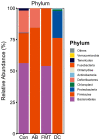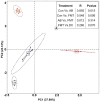Fecal microbiota transplantation from Suncus murinus, an obesity-resistant animal, to C57BL/6NCrSIc mice, and the antibiotic effects in the approach
- PMID: 37089571
- PMCID: PMC10117937
- DOI: 10.3389/fmicb.2023.1138983
Fecal microbiota transplantation from Suncus murinus, an obesity-resistant animal, to C57BL/6NCrSIc mice, and the antibiotic effects in the approach
Abstract
Introduction: Important studies on the relationship of the intestinal microbial flora with obesity have uncovered profound changes in the composition of the gut microbiota in obese individuals. Animal studies successfully altered body phenotypes by fecal microbiota transplantation (FMT).
Methods: In this study, we analyzed the gut microbiome of Suncus murinus (S. murinus), a naturally obesity-resistant animal, and the changes of the gut flora of C57BL/6NCrSIc mice that received gut bacteria transplantation from S. murinus by 16S rRNA gene analysis method. And analyzed and discussed the possible impact of the use of antibiotics before transplantation on the outcome of transplantation.
Results: Our results showed no significant changes in body weight in the FMT group compared to the control (AB) group, but large fluctuations due to antibiotics. There was no change in blood lipid levels between groups before and after FMT. The gut microbiota of S. murinus were enriched in Firmicutes and Proteobacteria, while Bacteroidetes were not detected, and fewer OTUs were detected in the intestine gut in comparison to other mouse groups. Statistically significant differences in alpha diversity were observed between the FMT group and other groups. Furthermore, a beta diversity analysis indicated an apparent structural separation between the FMT group and other groups.
Conclusion: It was suggested that the gut flora of S. murinus was not well established in the gut trace of mice through FMT, and the administration of antibiotics before transplantation was an important factor affecting the overall composition of the gut flora. Although FMT of S. murinus failed to completely colonize the intestinal tract of the mice, it still had a certain effect on the establishment of the intestinal flora of the mice. The unpredictable effects of pre-transplantation antibiotics on the results of transplantation cannot be ignored.
Keywords: 16S rRNA; Suncus murinus; antibiotics; fecal microbiota transplantation; gut microbiota; obesity-resistant.
Copyright © 2023 Zhang, Sasaki, Yang, Chen, Li, Yi, Li, He and Yi.
Conflict of interest statement
The authors declare that the research was conducted in the absence of any commercial or financial relationships that could be construed as a potential conflict of interest.
Figures









Similar articles
-
Gut microbiota of Suncus murinus, a naturally obesity-resistant animal, improves the ecological diversity of the gut microbiota in high-fat-diet-induced obese mice.PLoS One. 2023 Nov 22;18(11):e0293213. doi: 10.1371/journal.pone.0293213. eCollection 2023. PLoS One. 2023. PMID: 37992054 Free PMC article.
-
Spatial heterogeneity of bacterial colonization across different gut segments following inter-species microbiota transplantation.Microbiome. 2020 Nov 18;8(1):161. doi: 10.1186/s40168-020-00917-7. Microbiome. 2020. PMID: 33208178 Free PMC article.
-
Lactobacillus murinus alleviate intestinal ischemia/reperfusion injury through promoting the release of interleukin-10 from M2 macrophages via Toll-like receptor 2 signaling.Microbiome. 2022 Mar 3;10(1):38. doi: 10.1186/s40168-022-01227-w. Microbiome. 2022. PMID: 35241180 Free PMC article.
-
16S rDNA analysis of the effect of fecal microbiota transplantation on pulmonary and intestinal flora.3 Biotech. 2017 Dec;7(6):370. doi: 10.1007/s13205-017-0997-x. Epub 2017 Oct 12. 3 Biotech. 2017. PMID: 29071167 Free PMC article. Review.
-
[Fecal microbiota transplantation in the treatment of acute intestinal pseudo obstruction secondary to intracerebral hemorrhage: a case report and literature review].Zhonghua Wei Zhong Bing Ji Jiu Yi Xue. 2022 Mar;34(3):306-310. doi: 10.3760/cma.j.cn121430-20220225-00179. Zhonghua Wei Zhong Bing Ji Jiu Yi Xue. 2022. PMID: 35574751 Review. Chinese.
Cited by
-
Western Diet and fecal microbiota transplantation alter phenotypic, liver fatty acids, and gut metagenomics and metabolomics in Mtarc2 knockout mice.Genes Nutr. 2025 May 29;20(1):13. doi: 10.1186/s12263-025-00772-x. Genes Nutr. 2025. PMID: 40437401 Free PMC article.
-
Microbiological assessment of Suncus murinus bred and managed as laboratory animals.J Vet Med Sci. 2024 Jan 26;86(1):92-95. doi: 10.1292/jvms.23-0373. Epub 2023 Nov 27. J Vet Med Sci. 2024. PMID: 38008441 Free PMC article.
-
Gut microbiota of Suncus murinus, a naturally obesity-resistant animal, improves the ecological diversity of the gut microbiota in high-fat-diet-induced obese mice.PLoS One. 2023 Nov 22;18(11):e0293213. doi: 10.1371/journal.pone.0293213. eCollection 2023. PLoS One. 2023. PMID: 37992054 Free PMC article.
-
Safety and efficacy of fecal microbiota transplantation (FMT) as a modern adjuvant therapy in various diseases and disorders: a comprehensive literature review.Front Immunol. 2024 Sep 26;15:1439176. doi: 10.3389/fimmu.2024.1439176. eCollection 2024. Front Immunol. 2024. PMID: 39391303 Free PMC article. Review.
References
-
- Brooks P. T., Brakel K. A., Bell J. A., Bejcek C. E., Gilpin T., Brudvig J. M., et al. . (2017). Transplanted human fecal microbiota enhanced Guillain Barré syndrome autoantibody responses after Campylobacter jejuni infection in C57BL/6 mice. Microbiome 5:92. doi: 10.1186/s40168-017-0284-4, PMID: - DOI - PMC - PubMed
LinkOut - more resources
Full Text Sources

